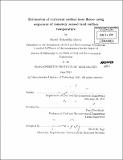Estimation of turbulent surface heat fluxes using sequences of remotely sensed land surface temperature
Author(s)
Bateni, Sayed Mohyeddin
DownloadFull printable version (37.64Mb)
Other Contributors
Massachusetts Institute of Technology. Dept. of Civil and Environmental Engineering.
Advisor
Dara Entekhabi.
Terms of use
Metadata
Show full item recordAbstract
Fluxes of heat and moisture at the land-surface play a significant role in the climate system. These fluxes interact with the overlying atmosphere and influence the characteristics of the planetary boundary layer (e.g. temperature and water vapor content), ultimately influencing the presence and growth of low level clouds and precipitation. Nevertheless, there is currently no network of in situ sensors that can map these fluxes globally. Recently a number of studies have focused on the estimation of surface energy flux components based on the assimilation of land surface temperature (LST) within a variational data assimilation (VDA) framework. This study provides the theoretical basis for why sequences of LST contain the necessary information to estimate surface fluxes with minimal reliance on ancillary data and empirical parameterizations. Furthermore this study addresses one of the main drawbacks of the existing VDA models. They use the simple force-restore equation for soil heat diffusion as a physical constraint. The force-restore equation provides a simplified description of the LST dynamics. Also, its performance is highly affected by the specification of a deep ground temperature. These shortcomings cause significant errors in the diurnal dynamics of heat diffusion in the soil and ultimately the retrieval of components of surface energy balance. This study advances the VDA scheme by using the full heat diffusion equation as a constraint in lieu of the forcerestore approximation. The new VDA scheme is tested over several experimental field sites. The results show that inclusion of the heat diffusion equation decreases the phase error associated with the ground heat flux diurnal cycle, and improves surface heat flux estimation. The VDA scheme is further advanced by incorporating model uncertainty in order to account for measurement and model errors. Tests indicate that the VDA scheme with model uncertainty captures measurement errors as well as structural model errors. In order to provide coupled estimates of surface heat fluxes and vegetation dynamics, remotely sensed LST and fraction of photosynthetically active radiation are assimilated into a surface energy balance and a vegetation dynamics model. The application of the assimilation over West Africa shows that the scheme provides reliable estimates of important vegetation dynamics parameters that are required for understanding the role of plant phenology on surface energy balance and vice-versa.
Description
Thesis (Ph. D.)--Massachusetts Institute of Technology, Dept. of Civil and Environmental Engineering, 2011. Cataloged from PDF version of thesis. Includes bibliographical references (p. 330-366).
Date issued
2011Department
Massachusetts Institute of Technology. Department of Civil and Environmental EngineeringPublisher
Massachusetts Institute of Technology
Keywords
Civil and Environmental Engineering.